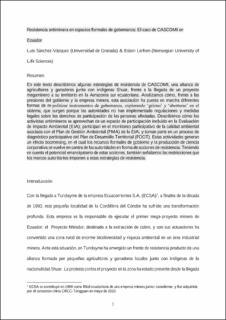| dc.contributor.author | Sánchez-Vázquez, Luis | |
| dc.contributor.author | Leifsen, Esben | |
| dc.date.accessioned | 2020-10-26T09:02:05Z | |
| dc.date.available | 2020-10-26T09:02:05Z | |
| dc.date.created | 2020-01-13T15:22:31Z | |
| dc.date.issued | 2019 | |
| dc.identifier.citation | Revista Europea de Estudios Latinoamericanos y del Caribe. 2019, 108 65-86. | en_US |
| dc.identifier.issn | 0924-0608 | |
| dc.identifier.uri | https://hdl.handle.net/11250/2684897 | |
| dc.description.abstract | En este texto describimos algunas estrategias de resistencia de CASCOMI, una alianza de agricultores y ganaderos junto con indígenas Shuar, frente a la llegada de un proyecto megaminero a su territorio en la Amazonía sur ecuatoriana. Analizamos cómo, frente a las presiones del gobierno y la empresa minera, esta asociación ha puesto en marcha diferentes formas de re-politizar instrumentos de gobernanza, explorando ‘grietas’ y ‘aberturas’ en el sistema, que surgen porque las autoridades no han implementado regulaciones y medidas legales sobre los derechos de participación de las personas afectadas. Describimos cómo los activistas antimineros se aprovechan de un espacio de participación incluido en la Evaluación de Impacto Ambiental (EIA); participan en el monitoreo participativo de la calidad ambiental asociada con el Plan de Gestión Ambiental (PMA) de la EIA; y toman parte en un proceso de diagnóstico participativo del Plan de Desarrollo Territorial (PDOT). Estas actividades generan un efecto boomerang, en el cual los recursos formales de gobierno y la producción de ciencia corporativa se vuelve en contra de las autoridades en forma de acciones de resistencia. Teniendo en cuenta el potencial emancipatorio de estas acciones, también señalamos las restricciones que los marcos autoritarios imponen a estas estrategias de resistencia. | en_US |
| dc.description.abstract | In this paper, we describe some of the strategies of resistance of CASCOMI, an association of peasents and indigenous Shuar, against the arrival of a megamining project to its territory in the southern Ecuadorian Amazon. Facing the pressure from the government and the mining company, we analyze how the association repoliticizes and makes new uses of formal participatory instruments, and explores ‘cracks’ and ‘openings’ in the governance system. Cracks and openings emerge due to the authorities’ failure to implement regulations and legal measures regarding affected people’s formal rights to participation. We consider how antimining activists take advantage of a space of participation included in the Environmental Impact Assessment (EIA); engage in participatory monitoring of environmental quality associated with the Environmental Management Plan (PMA) of the EIA; and take part in a process of participatory diagnosis of the Territorial Development Plan (PDOT). These activities generate a boomerang effect, in which formal resources of governance and corporate science production return to the authorities as a form of resistance work. Considering the emancipatory potential of these actions, we also look at the conditioning restrictions that authoritative framings place on these resistance strategies. | en_US |
| dc.language.iso | spa | en_US |
| dc.rights | Navngivelse 4.0 Internasjonal | * |
| dc.rights.uri | http://creativecommons.org/licenses/by/4.0/deed.no | * |
| dc.title | Resistencia antiminera en espacios formales de gobernanza: El caso de CASCOMI en Ecuador | en_US |
| dc.title.alternative | Anti-mining resistance in formal spaces of governance: The case of CASCOMI in Ecuador | en_US |
| dc.type | Peer reviewed | en_US |
| dc.type | Journal article | en_US |
| dc.description.version | acceptedVersion | en_US |
| dc.source.pagenumber | 65-86 | en_US |
| dc.source.volume | 108 | en_US |
| dc.source.journal | Revista Europea de Estudios Latinoamericanos y del Caribe | en_US |
| dc.identifier.doi | http://doi.org/10.32992/erlacs.10460 | |
| dc.identifier.cristin | 1771703 | |
| dc.relation.project | Norges forskningsråd: 236912 | en_US |
| cristin.unitcode | 192,13,1,0 | |
| cristin.unitname | Institutt for internasjonale miljø- og utviklingsstudier | |
| cristin.ispublished | true | |
| cristin.fulltext | postprint | |
| cristin.qualitycode | 1 | |

